Benefits
63% of Workers and Managers Say Productivity Has Risen or Stayed Same Since Covid
All companies surveyed, even those without a culture for remote work, had to manage employees working from home. They faced common challenges, including lack of face-to-face supervision, distractions at home, and social isolation.
Jun. 29, 2020
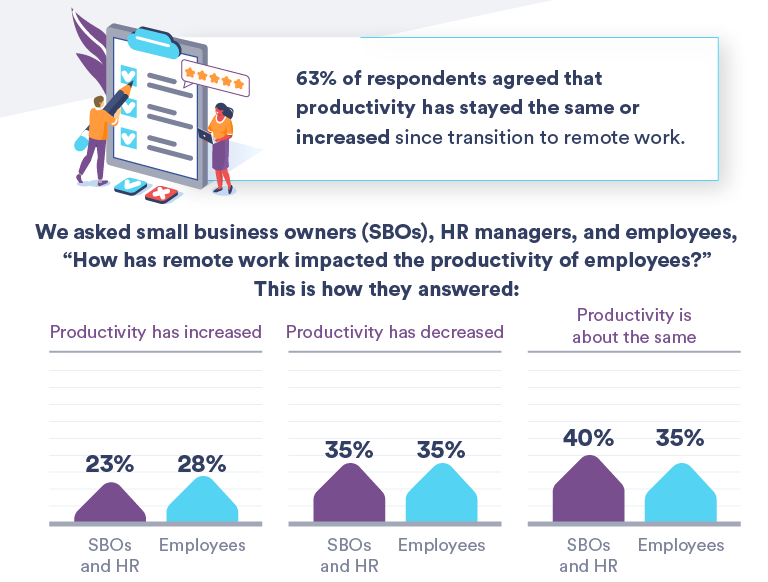
COVID-19 forced businesses of all sizes to switch to remote work instantaneously. Many businesses have touted the transition as a success — Facebook, Apple, Twitter, and Microsoft have embraced remote work, announcing some employees will work from home indefinitely.
As cities and states begin to reopen — even as coronavirus cases climb in areas where shelter in place requirements have been relaxed — small business owners and employees are thinking about how they will return to the office, or if they even do.
[This article first appeared on WORKEST, a Zenefits resource for small businesses.]
Will businesses continue to allow employees to remote work, or will they require them to return to a physical office? Will workers refuse to return to the office? What are businesses doing to prepare for reopening? What happens if an employee tests positive for COVID-19?
For a closer look at how employees and employers are thinking about life after lockdown, we surveyed more than 900 people in the U.S., including 293 small and mid-size business owners, 108 HR managers, and 501 full- and part-time employees, for their perspective on returning to work.
Read on as we explore how small business owners and employees feel about remote work, if they see themselves returning to an office, and what preparations they are making as states begin to reopen.
Remote work: Productive or not?
All companies, even those without a culture for remote work, had to manage employees working from home. They faced common challenges, including lack of face-to-face supervision, distractions at home, and social isolation.
Despite these hindrances, both employers and employees are on the same page — 63% of HR managers, small business owners, and employees all agreed that productivity has stayed the same or increased since transition to remote work.
From the small business owner’s and HR’s point of view, 40% said productivity has stayed the same, 23% said productivity increased, and 35% said productivity has decreased.
From an employee’s point of view, 35% said productivity has stayed the same, 28% said productivity has increased, and 35% said productivity decreased.
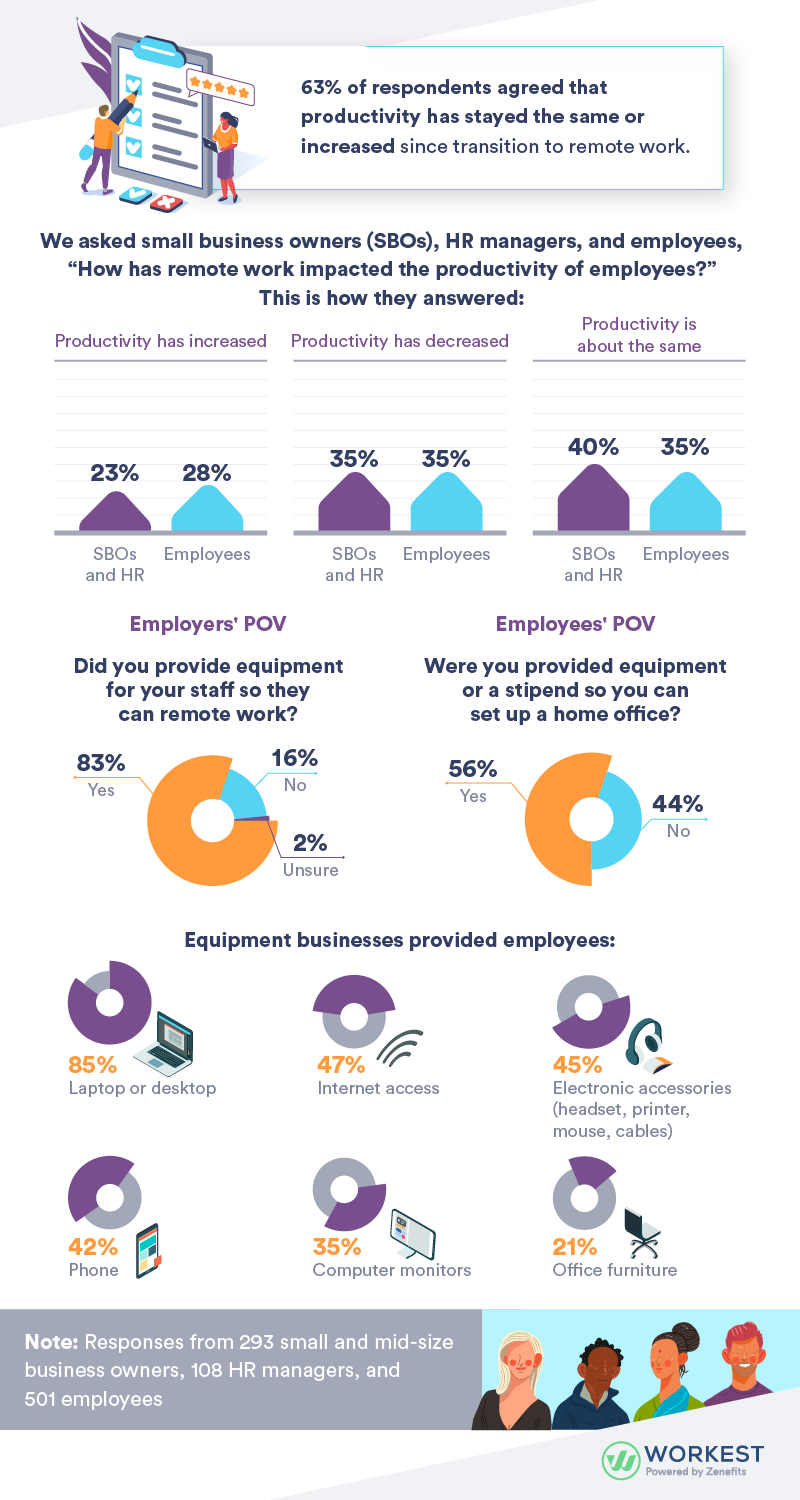
To set up employees for success, 83% of small business owners and HR managers said they provided equipment to their staff for remote work, including computer equipment, office furniture, phones, internet access, and electronic accessories.
But when we asked employees if they were provided equipment or a stipend so they can set up a home office, only 56% of employees said they were provided office equipment, and 44% said they weren’t provided anything.
If you’re a business owner who made a quick pivot to remote work, you may consider checking in with your team to see what tools they need to stay connected and productive. Popular project management and communication tools include Asana, Slack, Microsoft Teams, Zoom, and Google Hangouts. Providing tips on how to set up a dedicated workplace and facilitating virtual team bonding events from home can help employees feel supported and set them up for success.
Most businesses will recall remote workers back to the office
After 3 months of shutdowns, businesses are beginning to reopen across the country and asking their employees to return to work.
Most businesses surveyed said they will require employees to return to the office when their state gives the OK to reopen: 69% of small business owners and HR managers said they would require employees to return. Just 17% said they would not.
For the 17% of employers who are continuing to allow remote work, they cited “the risk of exposure does not outweigh the benefits of having an open office” (65%) as their top reason to keep employees at home. Employers also cited workers’ preference to work remote (45%), cost savings on rent, office supplies, snacks, and other expenses (35%), the risk of legal recourse if someone catches COVID-19 (28%), the expense of modifying to the workplace to comply with social distancing (17%), and increased productivity (16%).
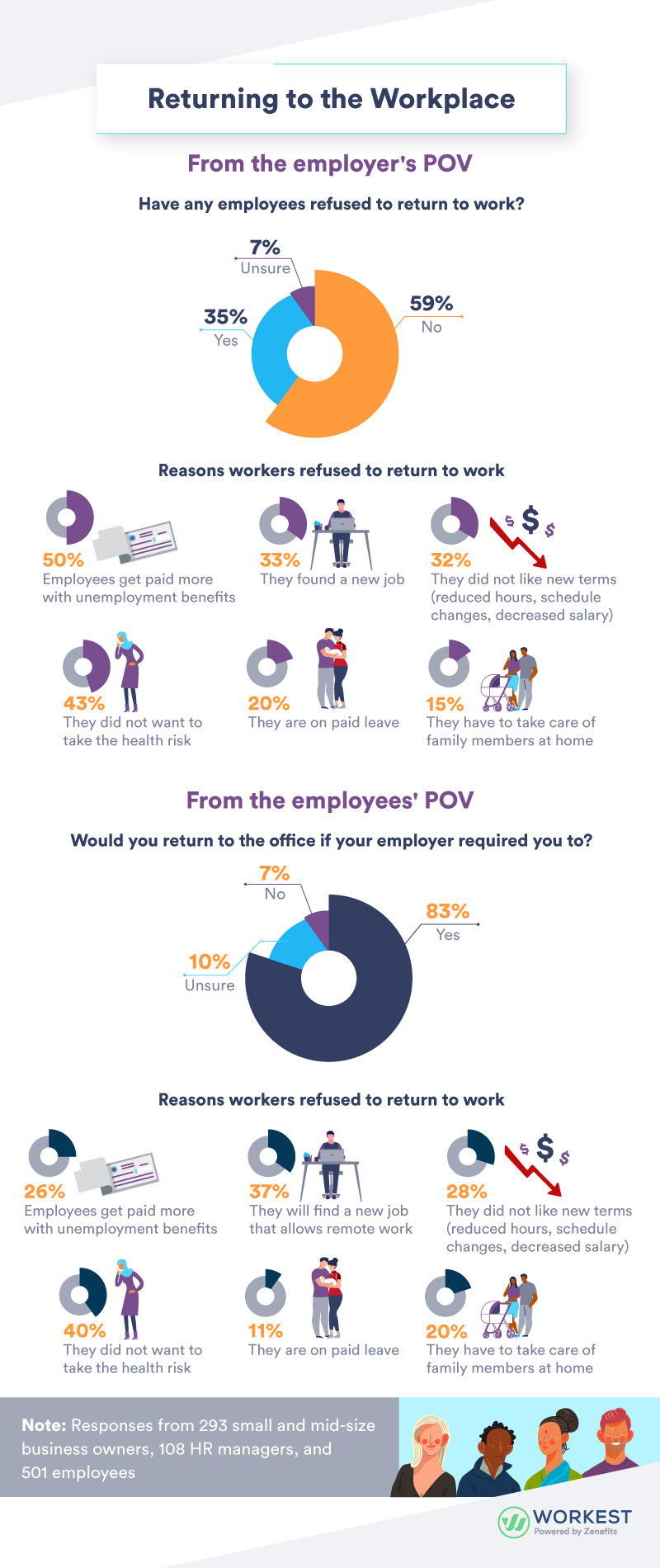
For the 69% of employers who are recalling their workers to return to the office, the majority said they are:
- Requiring employees to wear face masks (69%)
- Increasing access to cleaning/sanitization supplies (64%)
- Requiring customers to wear face masks (56%)
- Spacing workstations at least 6-feet apart (52%)
A small number of businesses, 5%, said they are not doing anything additional to prepare the office for reopening.
For businesses that are reopening, pay close attention to best practices and CDC guidelines to plan and prepare in case a customer or employee gets infected with COVID-19. As a small business owner or HR manager, consider who should return to the workplace (can you have a partially remote staff?), what safety measures to implement to protect employees and customers, what to do if you discover an employee has been infected in the workplace, and how you are going to communicate changes and updates to staff members.
Returning to work? 44% of employees would take a pay decrease to continue remote work
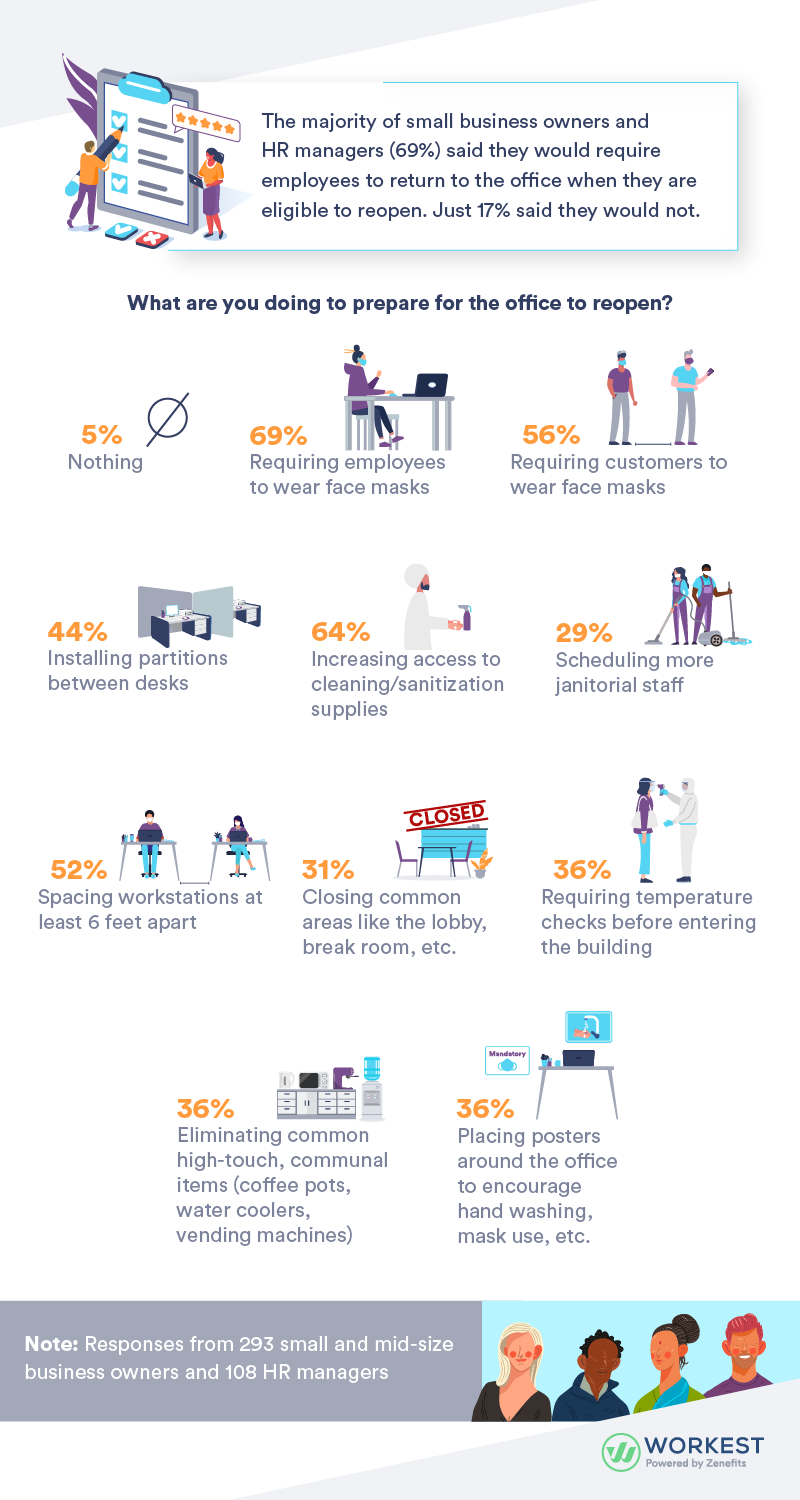
Businesses may be ready to reopen, but their employees are not. Employees are reluctant to return for a variety of reasons, including preference to work from home, anxiety about catching COVID-19, and not having childcare.
Before COVID-19, only 38% of employees said they worked remotely. Since the outbreak, over half (53%) of employees have requested to continue to work remotely or are planning to make the request in the future. Only 39% of employees said they would like to return to the office, but 83% said they would return if their employer required them to be in the office.
From the employees’ POV
In our survey, employees cited a variety of reasons for not returning to the office, including:
- Not wanting to take on the health risk (40%)
- Finding a new job that allows remote work (37%)
- Not liking new terms of employment, which include reduced hours, schedule changes, or decreased pay (28%)
- Getting paid more with unemployment benefits (26%)
- Taking care of family members (20%)
- Being on paid leave (11%)
From the small business owners’ and HR managers’ POV:
When we asked small business owners and HR managers if they had any employees refuse to return to work, 59% said no and 35% said yes.
The top reasons businesses heard from employees about not returning to work include:
- Getting paid more with unemployment benefits (50%)
- Not wanting to take on the health risk (43%)
- Employees found a new job (33%)
- Not liking new terms of employment, which include reduced hours, schedule changes, or decreased pay (32%)
- Being on paid leave (20%)
- Taking care of family members (15%)
As businesses consider permanent remote work, Mark Zuckerberg announced that half of Facebook will be working remotely permanently in the next 10 years — in exchange for a lower salary.
We posed this question to more than 500 employees: How much of a pay decrease would you accept to work remotely 100% of the time?
43% of employees said they would accept a pay decrease to remote work, compared to 52% of employees who said they would not accept a decrease. A small number, 4%, said they would expect a pay increase.
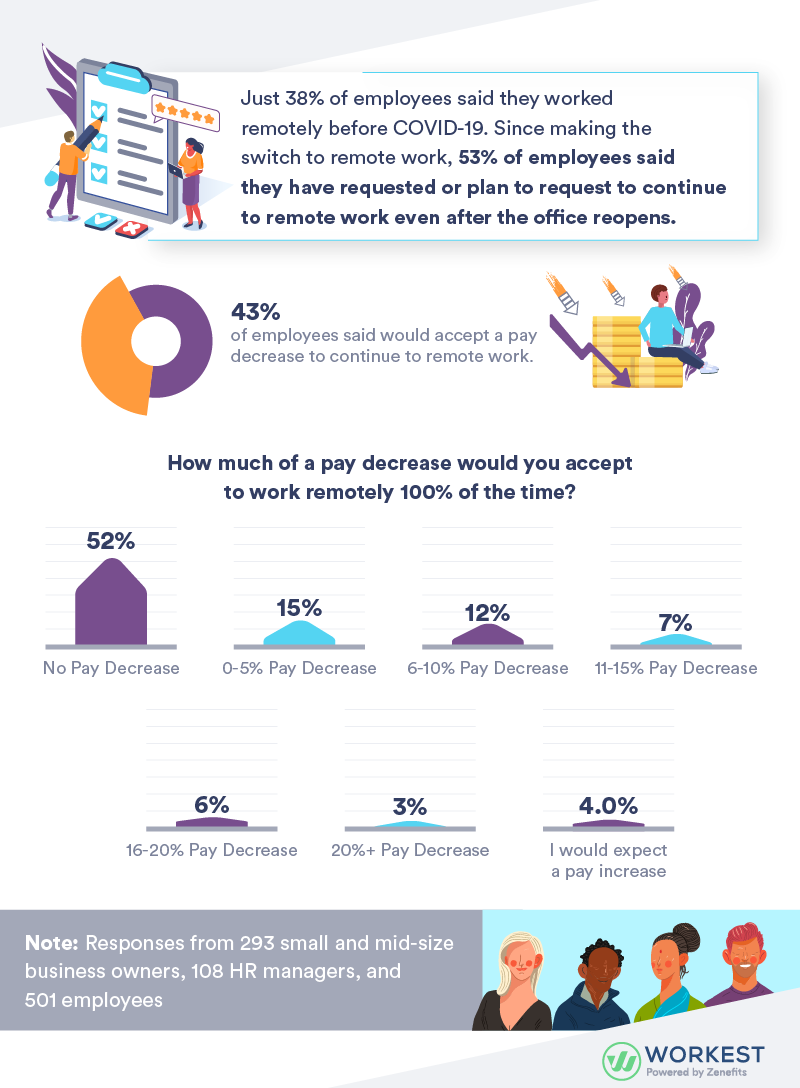
Sanitation and safety
Small business owners and HR managers are thinking about what precautions they have to take when they reopen the office. The majority of respondents (53%) said they would hire external staff to help prepare the workplace for reopening.
Respondents plan to include:
- Designers to reconfigure the office (49%)
- Additional janitorial / cleaning staff (49%)
- Temperature checkers (44%)
- Contact tracers (38%)
While large businesses may have the resources to increase sanitization efforts, most small business owners and HR managers said that cleaning the office will fall to a janitorial staff (47%), the business owner (27%), and staff members (25%).
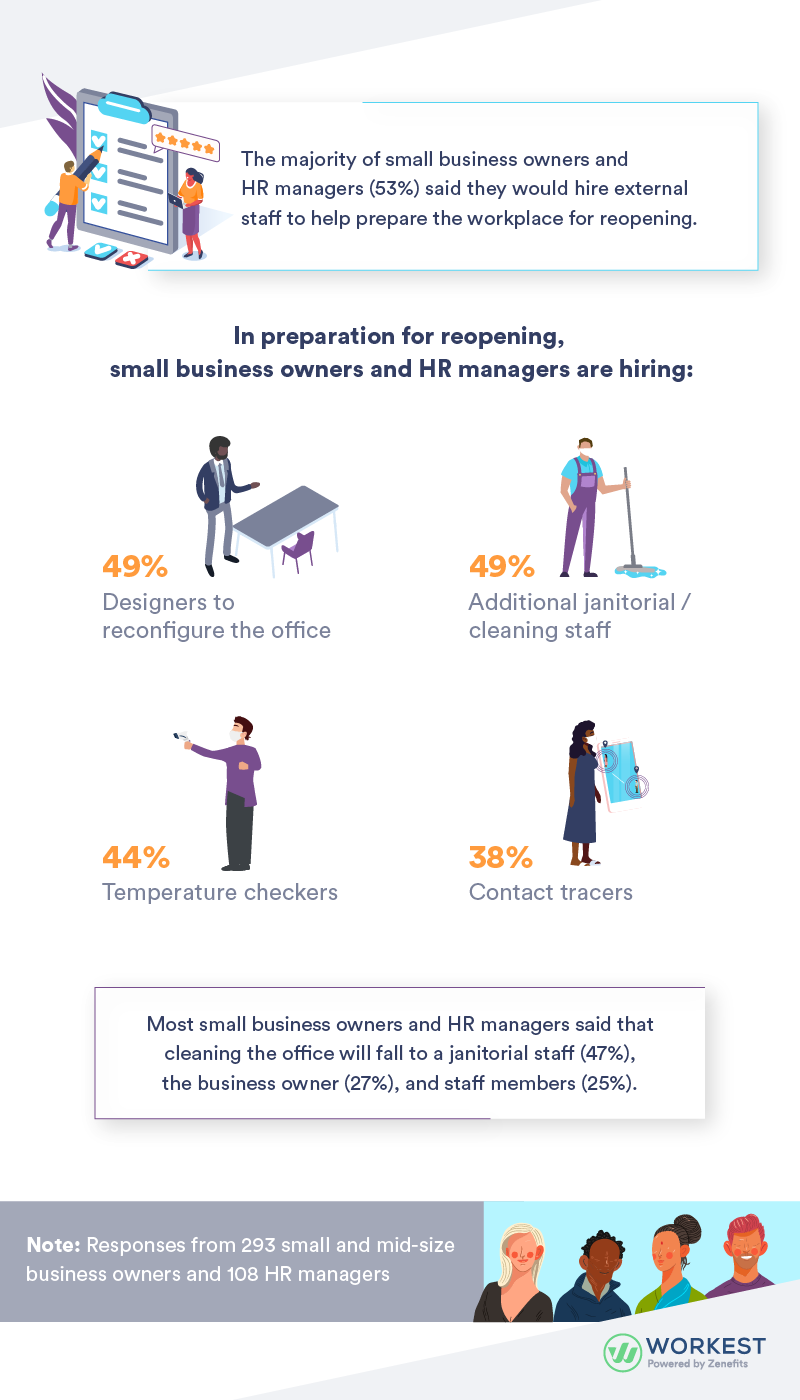
Exposed: Handling COVID cases at work
When it came to COVID-19 exposure, everyone was on the same page. The majority of business owners and HR managers (94%) and employees (87%) said they feel it’s important to know who in the office may have been exposed to COVID-19.
Most business owners and HR managers (84%) said they would inform the rest of the office if they found out an employee was exposed to COVID-19. A small number (11%) said they would not, and 5% of respondents were unsure.
Most business owners and HR managers (88%) said they think it’s their responsibility to notify employees if someone tests positive, and employees (89%) agreed.
When asked if they thought a daily test for COVID-19 symptoms for employees was a good idea, the answers were split:
- 64% of HR managers and small business owners and 66% of employees said they thought it was a good idea
- 25% of HR and small business owners and 19% of employees did not think it was a good idea
- 12% of HR managers and small business owners and 15% of employees were unsure
If a small business owner or HR manager found out someone in the office tested positive for COVID-19, they said they would require:
- The employee to stay for a week or more (66%)
- Them to stay away for a week or less (30%)
- Other employees to come to work with a face mask (42%)
- The infected employee to come back when they feel better (33%)
- A doctor’s note (21%)
Adapting to the future of work
Whether employers are embracing remote work or reopening their offices, it’s clear the future of work is rapidly changing in response to COVID-19. As business owners and HR managers recall employees to return to the office, they have to navigate the challenges of social distancing while implementing safety protocols to protect workers and customers from catching COVID-19. For those who will embrace remote work, they have to think about overcoming the challenges associated with a distributed workforce, which can include issues such as isolation, decreased productivity, and employee engagement.
At Zenefits, we help streamline your HR needs so you can focus on what matters most about running a business. With tools for simplifying your onboarding process, benefits, payroll, PTO, and hiring, Zenefits makes managing people easy and transparent. A complete HR platform can save you time and create a positive experience for you and your employees alike. Learn more by visiting us on the web at Zenefits.com today.
Methodology and limitations
We surveyed 902 employed people via SurveyGizmo from June 12-15, 2020, about returning to work during the COVID-19 pandemic. Of the 902 participants, 293 identified themselves as small and mid-size business owners, 108 identified themselves as HR managers, 430 identified themselves as a full-time employee, and 71 identified themselves as a part-time employee.
Small and mid-size businesses are defined as businesses with 4-499 employees.
Of all surveyed participants, 50% identified as female, and 50% identified as male. Respondents ranged in age from 18 to 64.
Of all business owners, 43% identified as female, and 57% identified as male; of all HR managers, 59% identified as female, and 41% identified as male; of all employees, 51% identified as female, and 49% identified as male.
The main limitation of the study is its reliance on self-reported data. Issues with self-reported responses include, but aren’t limited to, exaggeration, selective memory, telescoping, attribution, and recency bias.
============

About the author:
Andrea Curry
Andrea Curry is the content marketing manager at Zenefits. She began her career as a reporter in Hawaii, and transitioned to marketing because it combines her love of storytelling and data analytics (#nerdalert). Her first job was at a nature center, where she was in charge of feeding the wildlife.
